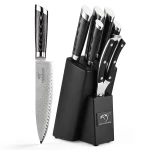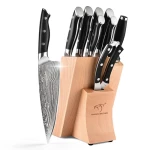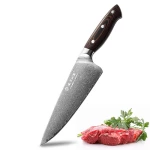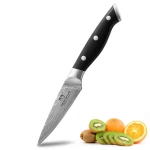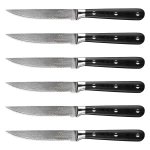How to Determine the Quality of a Chef's Knife: Insights into Craftsmanship and Materials
 Determining the quality of a chef's knife involves assessing various aspects of its craftsmanship and materials. Here are some insights into what to look for
Determining the quality of a chef's knife involves assessing various aspects of its craftsmanship and materials. Here are some insights into what to look for
1. Blade Material:
High-Quality Steel: Look for knives made from high-carbon stainless steel or Damascus steel. These materials offer durability, corrosion resistance, and edge retention.
Full Tang: A full tang knife has the blade extending fully into the handle, providing better balance and stability.
Forged vs. Stamped: Forged knives are generally of higher quality as they are made from a single piece of steel, resulting in better strength and durability compared to stamped knives.
2. Blade Construction:
Thickness: A thicker blade generally indicates durability, while a thinner blade offers precision and agility.
Edge Geometry: Consider the angle and shape of the blade's edge. A well-designed edge geometry ensures optimal cutting performance.
Handle Material: Look for handles made from durable materials like wood, plastic, or composite materials. The handle should offer a comfortable grip and be securely attached to the blade.
3. Balance and Weight:
Balance: A high-quality chef's knife should feel balanced in your hand, with the weight evenly distributed between the blade and the handle.
Weight: Choose a knife weight that suits your preference and intended use. Heavier knives may provide more power for cutting through tough ingredients, while lighter knives offer greater agility for intricate tasks.
4. Sharpness:
Out of the Box Sharpness: A quality chef's knife should come sharp out of the box, ready for use.
Edge Retention: Consider how well the knife maintains its sharpness over time. High-quality materials and craftsmanship contribute to better edge retention.
5. Craftsmanship:
Attention to Detail: Examine the knife for signs of meticulous craftsmanship, such as smooth edges, seamless transitions between the blade and handle, and uniform grinds.
Quality Control: Choose knives from reputable brands known for their commitment to quality and precision manufacturing processes.
6. Price vs. Value:
Value Proposition: While price can be an indicator of quality, it's not the sole determinant. Consider the overall value offered by the knife in terms of performance, durability, and craftsmanship.
Budget Considerations: Determine your budget and look for knives that offer the best combination of quality and affordability within your price range.
7. Ergonomics:
Comfort: Opt for a knife that feels comfortable in your hand, with an ergonomic handle design that reduces fatigue during extended use.
Grip: Choose a knife with a grip that suits your hand size and preferred grip style, whether it's a pinch grip or a full grip.
8. Reputation and Reviews:
Research: Read reviews and seek recommendations from trusted sources, such as professional chefs, culinary experts, and online forums.
Brand Reputation: Consider the reputation of the brand and its history of producing high-quality knives.
By considering these factors, you can make an informed decision when selecting a chef's knife that meets your needs and expectations in terms of quality and performance.

